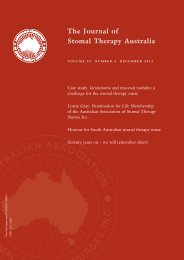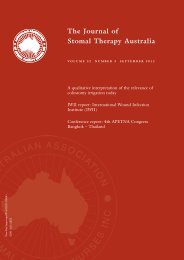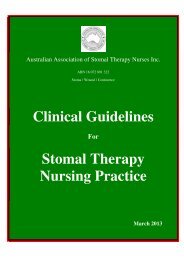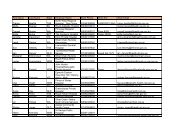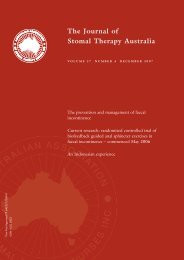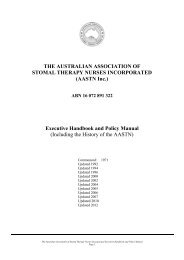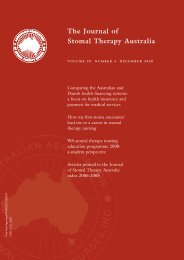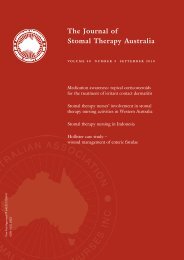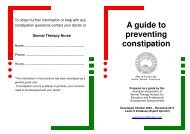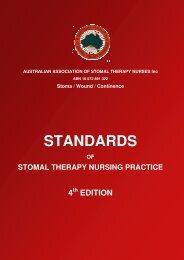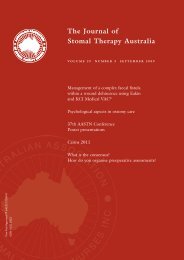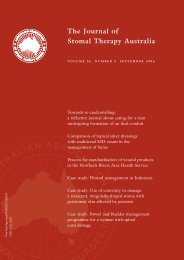The Journal of Stomal Therapy Australia - Australian Association of ...
The Journal of Stomal Therapy Australia - Australian Association of ...
The Journal of Stomal Therapy Australia - Australian Association of ...
Create successful ePaper yourself
Turn your PDF publications into a flip-book with our unique Google optimized e-Paper software.
Only 11.7% <strong>of</strong> clients were discharged into acute care for a stoma<br />
related problem. For these clients, the stoma related problems<br />
that created the greatest need for an acute discharge were an<br />
inability to manage the stoma and skin problems (see Table 2).<br />
Count <strong>of</strong> % <strong>of</strong> responses<br />
responses<br />
Cerebral vascular accident 2 4.7<br />
Count <strong>of</strong><br />
responses<br />
% <strong>of</strong> responses<br />
Dehydration 2 4.7<br />
Renal failure 1 2.3<br />
Prolapse 1 10.0<br />
Skin problems 3 30.0<br />
Uncontrolled leakage<br />
<strong>of</strong> appliance 1 10.0<br />
Inability to manage stoma 4 40.0<br />
Infection 1 10.0<br />
TOTAL 10* 100.0<br />
* Valid responses – multiple responses per episode may be<br />
recorded<br />
Table 2. Stoma problems related to discharge<br />
<strong>The</strong> specific surgery related problems associated with the<br />
discharge into acute care for seven clients are shown in Table 3.<br />
A variety <strong>of</strong> surgery related issues were identified.<br />
Table 4 presents the other medical problems related to the<br />
discharge into acute care. <strong>The</strong>re was considerable diversity in<br />
responses identified as ‘other medical problems’, the majority <strong>of</strong><br />
which did not fit into the pre-existing categories in the audit tool<br />
and required considerable recoding into meaningful categories.<br />
One third <strong>of</strong> medical problems remained in the ‘other’ options<br />
as they were unique conditions that did not warrant a category<br />
and did not fit with other items into a more general category.<br />
Count <strong>of</strong><br />
responses<br />
% <strong>of</strong> responses<br />
Wound infection 2 20.0<br />
Wound dehiscence 1 10.0<br />
Bowel obstruction 1 10.0<br />
Sepsis 1 10.0<br />
Development <strong>of</strong> a fistula 1 10.0<br />
Other surgical problems 4 40.0<br />
TOTAL 10* 100.0<br />
* Valid responses – multiple responses per episode may be<br />
recorded<br />
Table 3. Surgical problems related to discharge<br />
Wound 4 9.3<br />
Peg tube management 1 2.3<br />
IDC/ SPC continence<br />
management 5 11.6<br />
Neurological disorder 1 2.3<br />
Respiratory disorder 5 11.6<br />
Cardiovascular disorder 3 7.0<br />
Renal disorders/ UTI 4 9.3<br />
Diabetes 1 2.3<br />
Other medical problem 14 32.6<br />
TOTAL 43 100.0<br />
* Valid responses – multiple responses per episode may be<br />
recorded<br />
Table 4. Other medical problems related to discharge<br />
Some <strong>of</strong> the more common medical problems included<br />
problems ‘indwelling catheter and suprapubic catheter (IDC/<br />
SPC) continence management’ and ‘respiratory disorder’ (both<br />
11.6%). A further 9.3% <strong>of</strong> episodes recorded the discharge into<br />
acute care as being for a ‘wound related matter’ and ‘renal<br />
disorder or UTI’.<br />
Stoma problems experienced during the episode<br />
In addition to recording whether the discharge was related to<br />
the client’s stoma, the audit also reviewed if and what stoma<br />
problems were experienced during the episode.<br />
Of the episodes recorded 36.0% experienced a stoma problem.<br />
Where stoma problems were reported, 58.8/5 were skin<br />
related and 41.2% were related to uncontrolled leakage <strong>of</strong> the<br />
appliance.<br />
Involvement <strong>of</strong> ST CNCs in the episode<br />
ST CNCs saw 32.1% <strong>of</strong> clients during their episode and 93.1% <strong>of</strong><br />
clients with a stoma who were discharged into acute care were<br />
discharged by a field (generalist) nurse, with only four clients<br />
discharged by a CNC.<br />
Episodes in which the ST CNC saw the client were more likely<br />
to be episodes where a stoma problem was observed [χ 2 (1) =<br />
JOURNAL OF STOMAL THERAPY AUSTRALIA 2007 27(3) 11



